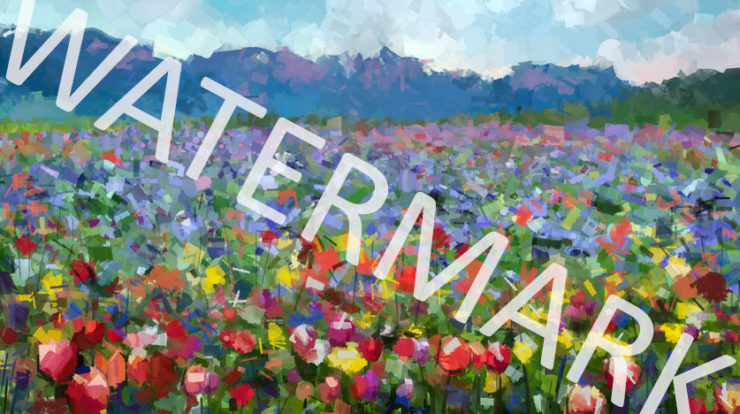
I am frequently asked by artists whether they should watermark their artwork before sharing it online. There seems to be a pretty widespread concern that posting artwork images online could lead to unauthorized reproduction or theft of the artwork. I don’t dismiss this threat out of hand; the theft of intellectual property is a very real problem. I would argue, however, that a watermark is a pretty poor way to deal with the problem and that watermarks defeat the purpose of sharing work online in the first place.
If you are sharing your artwork online, you are likely doing so in order to achieve broader exposure for your work, build recognition for yourself and your work, and generate sales. In order to achieve these aims you want to show your art in its best possible light. Having looked at thousands (probably tens of thousands) of artwork images online, I would argue that the appeal of artwork is considerably diminished by including a watermark. Think about what a watermark accomplishes – it mars the artwork to an extent that a would-be thief wouldn’t want to steal it to reproduce it. That marring of the image will just as certainly diminish the appeal of the piece to a potential promoter or buyer of your work.
I would also argue that the decrease in appeal outweighs any protection you receive from a watermark. An important benefit of posting your art online is the increased exposure your work gets when it is shared. Viewers are less likely to share artwork that is watermarked.
The likelihood of theft is pretty low. While there is a lot of intellectual property theft occurring online, it’s good to remember that there is an overwhelming amount of art online. The chances of your work showing up on t-shirts made in China is extremely low.
Typically, the images you share online are pretty low resolution. These images would result in poor reproductions.
There are legitimate legal reasons to assert your copyright when you post your work online, but a general notice on your website or a caption below your artwork will provide the same benefit without diminishing the appearance of your actual artwork.
If you have questions or concerns about your copyright and how to protect it, you should discuss the issues with an attorney who has experience protecting intellectual property. Last year I interviewed Steve Schlachman, a prominent IP attorney – watch that interview here.
What Do You Think – Should Online Artwork Be Watermarked?
Do you watermark the art you post online? Why, or why not? Do you have counter-arguments that I’ve failed to consider? Please share your thoughts in the comments below.
Updated: Examples of Watermarks Added
Thanks to everyone for posting your opinions on this matter in the comments – you’ve made excellent points. Some of you have been kind enough to send examples of your watermarking to give some ideas of your approach.

http://JillsFotoLuv.com

http://www.mattsuess.com/


Unobtrusively. More important is to not give away the image in a large size. I limit my postings to either 500 or 600 pixels long dimension and add my ©Larry Berman in 18 point arial font. In the corner. My sports pictures, which are much more valuable than my art pictures have my copyright filling the vertical width of the 500 (short dimension) pixel image because those images get taken and used all the time. And they are 99% verticals. I just finished scanning over 5000 slides from my film days and are posting 600 pixel images on Facebook with my 18 point copyright.
Thanks for a thought-provoking article! I have a couple of thoughts.
First, I’ve seen mentions of programs that “erase” watermarks. I don’t know how good they are… and I’m sure that they’d work better on some watermarks (for instance, watermarks with fine lines) than others. Someone who’s that desperate to get low-resolution copies probably isn’t going to buy the art anyway.
Second, I’ve seen elegant watermarks that enhance a photo. That’s especially true if the watermark is fairly small and put in a spot that fits the composition so it isn’t obtrusive (vs. always putting the watermark in the same place, and the same size, on every photo). It’s something like the way a painter might sign their work — not necessarily in the lower right corner.
I don’t “watermark” but I do add my logo (usually, when sharing on IG or FB) – either my stylized signature or my chop. That way when people share my images, other people who see them will know who the artist is. It drives me crazy when people share images without attribution.
I’m in the process of switching website hosts, and the new one has a protocol I agree with: the watermark is not opaque so you can see the painting beneath, and it’s only applied to the Original works whose files are large enough to reproduce with any quality. The giclee print pages of the same images do not have the watermark, but copying is prohibited on those images and the image files are too small to reproduce anyway. That works for me.
Just an aside, I know of photographer that specializes in macro shots of snowflakes. They are really quite good. By using Google search, he can find out who is using his images without a release. He does enforce compliance and makes a pretty good annual income.
Thanks for adding that !
How did he search to find the abusers??
There are different ways to watermark your works, some in non-obtrusive ways. But also consider steganography, which allows you to embed content, such as a copyright statement. There are several companies that do this for other purposes such as tracking.
I think it perfectly reasonable to do, there are tools available for most platforms (free and otherwise) that facilitate it.
And despite this, I am lazy and have to do this to some of the content I’ve posted! Go figure 🙂
The term ‘watermark’ is used too broadly to make blanket statements. While I certainly agree that obscuring the image of a work of art is counterproductive, it is also true that most buyers prefer signed art to unsigned art. For painting, a visible signature is a tradition that is centuries old. It is becoming more common for all other art forms, too. An elegant signature of appropriate size, color, and placement can be an enhancement to the perception that the image on a webpage is fine art.
I agree that a signature or other watermark is weak protection against image theft. I wouldn’t use the copyright symbol © on an image, nor fonts usually used in books or on webpages, because they detract from the impression that ‘this is art’. But a nice signature can increase the chances that people who view your art can discover your name and find you later, if the image has been reposted, or if someone has downloaded it into their ‘save for later perusal’ folder.
After a decade of having a website and social media… during the pandemic I decided to open a Etsy shop not thinking of any problems. Someone decided to not only steal all my images and open fraudulent websites on the internet but have also took my real 5 star reviews from the site with images of me. So I now have over 190 works online that are all using my name ,images and reviews. One iimage advertising a original painting for $5000.00 to limited edition prints for $30.00 . Reporting these thefts is pain staking and when one gets taken down a new fraudulent one goes up . There is also suggestions for other art from other artists I assume all stolen too. Years of works taken with no regard for anything. I unfortunately am a person who is blindsided to this but I’m very frustrated with being used by such people for their personal gain.
A watermark is useless for theft protection because the works can simply be painted again by a skilled copyist using even the most rudimentary of image sources. A high resolution image on the internet is just a give away of the copyright but the standard website images are effectively useless to those who simply want to print it off. If you really expect to find copyright infringement or copies of your work appear on products out of china/thailand/ etc etc good luck because you will NEVER RECEIVE SATISFACTION from any resultant legal case. It is generally not worth their time copying your work as too hard to distribute, at most it will be an altered image copy targeted to a specific niche market they may have developed. lessons from 45 years as a publisher, artist and distributor of art globally. use the low res images on the net and do not send hi res to anyone.
Good comments, good article on a subject I had not considered.
In deciding to get back into painting, I spent time looking at numerous sites (Singulart, Etsy, etc) just to see what others were doing in drawing, photography (wow! some of that was blow me down gorgeous!), painting and AI art. Those images with noticeable watermarks were just blips, passed over with no thought. Images without watermarks that caught my eye, I would stop scrolling and just appreciate for awhile.
I suspect that others do what I do. Yes, I still amble through those sites when I hit a painter’s block; it’s almost as good as a walk in the woods for sparking inspiration.
Thank you, Jason, for this very informative article. It’s been a very challenging issue, to watermark or not to watermark. My artist friends usually haven’t , I did. I’m at the point in my career where sharing the work is more important than keeping it “safe”. Again, thanks for your clarity on this topic.
Thank you for posting this information. I have never used a watermark…actually don’t have the foggiest idea how…but I do post my work on my art page. Years ago when I did outdoor shows, someone took a photo of one of my pieces and replicated then let me know! Lots of gall out there…but at the time, I was so new to the art scene, I felt complimented instead of angry. Live and learn. I was thinking of opening an Etsy shop, but from other comments, seems that is not the way to go.
I learned a lot from all the people who shared their thoughts. Thanks again.
I do not use watermarks, as what limited protection they provide will soon be negated by smart(er) photo editors. And it would be straightforward to copy a painting removing a watermark. I ensure that I’ve signed all my art posted online, even work-in-progress.
As a photographer who uses digital tools like Photoshop extensively, I can say that anything but the most obtrusive watermark or copyright statement embedded in an image is child’s play to remove. Especially those in out-of-the-way parts of the image where they don’t detract very much from viewing the art, like along the edge or in a corner. AI tools like Generative Fill in Photoshop make it as simple as quickly drawing a crude selection around the watermark and pressing a button. I’ve used this to remove distracting elements from my photos that couldn’t be avoided when I composed the photo, like trash cans or traffic cones (I shoot in city environments a lot). The results are fast and usually amazing, and would be unnoticeable by anyone except perhaps an expert. So, I’ve not made any attempts to watermark my photos on my web site. I just kept the size relatively small and disabled right-click to make it a little harder to copy and paste my images. Of course, a screen capture is always possible, but I figure anything I can do to make my images harder to grab might deter someone enough that they move on and steal someone else’s photos. 🙂 In the end, I feel that the possibility of theft is just something we have to live with, and the odds of my work being stolen are pretty low, as Jason pointed out.
I place a visible signature on anything that is posted on line. Not so much for theft protection but to give viewers a breadcrumb trail back to me. If an image is shared on social media it’s simple to find the artist. But if it’s copied/pasted without any identification it can become an orphan very quickly. A signature lets the image continue to advertise for me even if it is screen capped.
Bingo! I was waiting for someone to bring this up.
I feel the exact same way. My watermark is just so interested parties can go find my work, and I usually only put it on images that I feel will be shared or that are kinda high traffic.
Thank you.
One of my friends recently found out that someone was using her images to apply (& get accepted to) art shows, & the thief’s actual products aren’t even the same type of art (or art at all)! I doubt the event organizers realized the vendor didn’t actually qualify for participation (I’ve been in too many events that included vendors whose products didn’t come close to the application criteria, but weren’t ejected).
The link to the Steve Schlachman interview did not work.